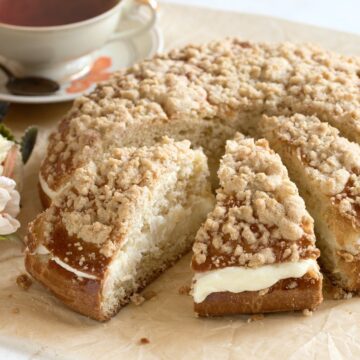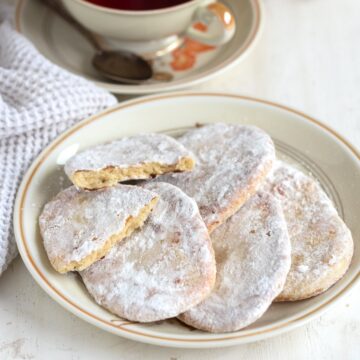Today I'm going to take you to Slovakia! This small European country borders the Czech Republic on the eastern side. We will make their famous potato flatbread, called lokše.

What Are Lokše?
Lokše (plural) are a type of thin Slovakian flatbread made of potato dough, baked dry in a pan. After baking, they require brushing with melted lard or butter.
Lokše themselves taste neutral. Traditionally in Slovakia, they are served folded as a side to savory dishes or on their own stuffed with sauerkraut and minced meat.
Slovaks call these potato pancakes "zemiakové lokše". Czechs call them "bramborové lokše".
TIP: Slovak lokše resemble Czech palačinky!
Lokše are a staple of Slovak cuisine, and from there, they’ve spread across the border into Moravia, an eastern part of the Czech Republic. My father-in-law comes from Moravia, where they used to prepare lokše in a sweet version, spread over with plum jam (povidla) and rolled up.
And it is this delightful variant that I describe in the recipe below.
Ingredients

To make original lokše, you only need two ingredients: grated potatoes and just enough flour to make a smooth, non-sticky dough. This recipe makes perfect use of leftover potatoes from the previous day.
- Potatoes; boiled ahead without skin, cooled
- All-purpose flour; for potato dough + dusting
- Salt
- Pork lard; or unsalted butter for brushing finished lokše
- Plum jam; as a filling, or any other solid jam
✅ You’ll find the exact amount of ingredients below in the recipe card, which you can also print out.
Instructions with Photos
STEP 1: Boil the peeled potatoes in lightly salted water until tender. Let them cool down.
STEP 2: Grate the cooled potatoes finely.

STEP 3: Add flour, salt, and create a smooth, non-sticky potato dough.

STEP 4: Divide the dough into equally sized pieces.

STEP 5: Dust the worktop with flour. Roll out each piece into a thin circle about 8 inches (20 cm) in diameter.

STEP 6: Preheat an iron skillet well, bake each lokše on a dry pan from both sides until golden.

STEP 7: Brush hot lokše on both sides with melted lard or butter.

STEP 8: Allow them to cool for a while, spread with jam, roll up, and you're done!

Serving
According to this recipe, the best way to enjoy lokše is to eat them warm, spread with sweet jam, and rolled. Ideal as a breakfast or snack!

Equipment
Our grandmothers used to bake lokše on a cast-iron stove, and modern homemakers bake them on a cast-iron skillet.
Since the lokše are about 8 inches in diameter, use a pan at least 10 inches wide to prepare them.

Cook's Tips
- When preparing lokše, add just enough flour to the grated potatoes to make a non-sticky dough. If there is too much flour, the pancakes will be dense.
- Properly prepared potato dough will puff up during baking. This means that the lokše will be perfectly soft and tender.
- Between baking each lokše, wipe the pan clean of any leftover flour; otherwise, it will burn.
More Czech sweet recipes:
- Apple strudel – tried and tested recipe
- Plum streusel coffee cake – easy to make and so delicious!
- Kaiserschmarrn – shredded pancake, in Czech "trhanec"
Recipe card

Lokše Potato Flatbread
Ingredients
- 1 lb (450 g) potatoes skinless boiled
- 1 cup (130 g) all-purpose flour plus for dusting worktop while rolling up the potato dough
- pinch of salt
- pork lard or butter, for topping cooked lokše
- plum jam or other solid jam, for filling
Instructions
- Boil the peeled potatoes in lightly salted water until tender. Let them cool down.
- Grate the cooled potatoes finely.
- Add flour, salt, and create a smooth, non-sticky potato dough.
- Divide the dough into equally sized pieces.
- Dust the worktop with flour. Roll out each piece into a thin circle about 8 inches (20 cm) in diameter.
- Preheat an iron skillet well, fry each lokše on a dry pan from both sides until golden.
- Brush hot lokše from both sides with melted lard or butter.
- Allow them to cool for a while, spread with jam, roll up, and you're done!
Notes
- Makes about 6 lokše.
- When preparing lokše, add just enough flour to the grated potatoes to make a non-sticky dough. If there is too much flour, the pancakes will be dense.
- Properly prepared potato dough will puff up during baking. This means that the lokše will be perfectly soft and tender.
- Between baking each lokše, wipe the pan clean of any leftover flour; otherwise, it will burn.
DISCLAIMER: Because I come from Central Europe, my recipes are based on metric units such as grams or milliliters. Check out how I convert metric units to the U.S. system:
Conversion chart Nutrition Disclosure





DH
This dish seems to be a bit less thin and doesn't have the cream in the dough, but it reminds me of lefse, which is very popular in North Dakota where I live. Maybe next time I have leftover potatoes I will give this a shot.
There are a lot of recipes on your website that I am eager to try. Thank you for including both the detailed instructions with pictures and a more concise recipe. So many blogs just have the story and detailed instructions interrupted by pictures, and that is annoying when it comes time to actually make the dish. However, it is still nice to see how something is done if it is unfamiliar. So thank you for having both.
Petra Kupská
Hi, thank you for your kind comment and supportive words. You're right, when I was doing a little research in preparing lokše recipe, I also came across lefse. I think both recipes make good use of any leftover cooked potatoes and turn them into a tasty meal. In former Czechoslovakia, potatoes were a very cultivated crop. It was one of the ingredients that we always had plenty of in the shops in the ex-communist era. That's why you can find many recipes in Czech cookbooks where potatoes are the main component. Greetings from the Czech Republic, Petra
Brenda
These remind me of my gramma. She’d keep them warm between pillows as she cooked. My job (5yrs old) was to sit on the pillows to keep the warmth in but as an adult I realize it was to keep me out of the way. Either way it’s a fond memory. We served them by browning butter to which milk and then sugar was added. A spoonful was drizzle on each pancake and they were stacked flat on each other. The balance of this sauce was spooned over top and delicious pie shaped wedges were cut and served.
Petra Kupská
Brenda, thank you for sharing your fond memory of guarding the dish in pillows. Our grannies were simply savvy and very resourceful when it came to keeping their grandkids occupied, which is why we love them so much!
William Milan Uhlarik
My mother and grandmother when they were alive used to make Zemiakové Lokše. They usually made them to eat during Lent on the days as Roman & Ruthenian Rite Catholics we would fast and abstain from meat. But they also made them other times of the year. They were delicious and quite simple to make. We would eat them with melted butter with some crushed garlic spread over them, various soups, Kyslá Kapusta, et al. Since many of us Czechoslovaks were not rich, we learned to use the simple inexpensive foods we could afford to buy and turned them into gastronomic gourmet delights. I love my peasant food! LOL........ I am always amazed and delighted how many of my American friends who have never eaten Czechoslovak cooking clean their plate and ask for seconds whenever my mother or grandmother cooked, and they joined us for a meal. As kids I and my siblings learned to cook our old country cuisine by watching and helping them in the kitchen starting at an early age. So, I try to keep our culture and traditions alive by cooking the same for my family and friends.
Petra Kupská
Milan, you always describe your culinary experiences in a way that makes one drool! I got this recipe for Lokše from my father-in-law, who comes from the Moravian town of Jemnice. They always ate Lokše with plum jam (povidla or lekvar) spread over them and rolled up, as you can see in the photo. I've also seen them arranged on a plate with roast goose or duck and cabbage. I think that in some regions of the Czech Republic they are also called "patenty". Please keep up the tradition; perhaps one day I'll come to your house for a delicious Slovak dinner! 🙂
Ancient Hippie
Thanks for the recipe. My slovak grandmother would make these for us everytime we visited. We'd go home with dozens. Probably one of my favorite foods as a child.
Anicka Cooklikeczechs.com
Thank you for your comment and nice memories!